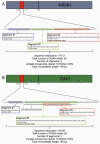EWS/FLI-responsive GGAA microsatellites exhibit polymorphic differences between European and African populations
- PMID: 22749036
- PMCID: PMC3389350
- DOI: 10.1016/j.cancergen.2012.04.004
EWS/FLI-responsive GGAA microsatellites exhibit polymorphic differences between European and African populations
Abstract
The genetics of Ewing sarcoma development remain obscure. The incidence of Ewing sarcoma is ten-fold less in Africans as compared to Europeans, irrespective of geographic location, suggesting population-specific genetic influences. Since GGAA-containing microsatellites within key target genes are necessary for Ewing sarcoma-specific EWS/FLI DNA binding and gene activation, and gene expression is positively correlated with the number of repeat motifs in the promoter/enhancer region, we sought to determine if significant polymorphisms exist between African and European populations which might contribute to observed differences in Ewing sarcoma incidence and outcomes. GGAA microsatellites upstream of two critical EWS/FLI target genes, NR0B1 and CAV1, were sequenced from subjects of European and African descent. While the characteristics of the CAV1 promoter microsatellites were similar across both populations, the NR0B1 microsatellite in African subjects was significantly larger, harboring more repeat motifs, a greater number of repeat segments, and longer consecutive repeats, than in European subjects. These results are biologically intriguing as NR0B1 was the most highly enriched EWS/FLI bound gene in prior studies, and is absolutely necessary for oncogenic transformation in Ewing sarcoma. These data suggest that GGAA microsatellite polymorphisms in the NR0B1 gene might influence disease susceptibility and prognosis in Ewing sarcoma in unanticipated ways.
Copyright © 2012 Elsevier Inc. All rights reserved.
Figures




References
-
- Grier HE, Krailo MD, Tarbell NJ, et al. Addition of ifosfamide and etoposide to standard chemotherapy for Ewing’s sarcoma and primitive neuroectodermal tumor of bone. N Engl J Med. 2003;348:694–701. - PubMed
-
- Balamuth NJ, Womer RB. Ewing’s sarcoma. Lancet Oncol. 2010;11:184–92. - PubMed
-
- Cotterill SJ, Ahrens S, Paulussen M, et al. Prognostic factors in Ewing’s tumor of bone: analysis of 975 patients from the European Intergroup Cooperative Ewing’s Sarcoma Study Group. J Clin Oncol. 2000;18:3108–14. - PubMed
-
- Maheshwari AV, Cheng EY. Ewing sarcoma family of tumors. J Am Acad Orthop Surg. 2010;18:94–107. - PubMed
Publication types
MeSH terms
Substances
Grants and funding
LinkOut - more resources
Full Text Sources

